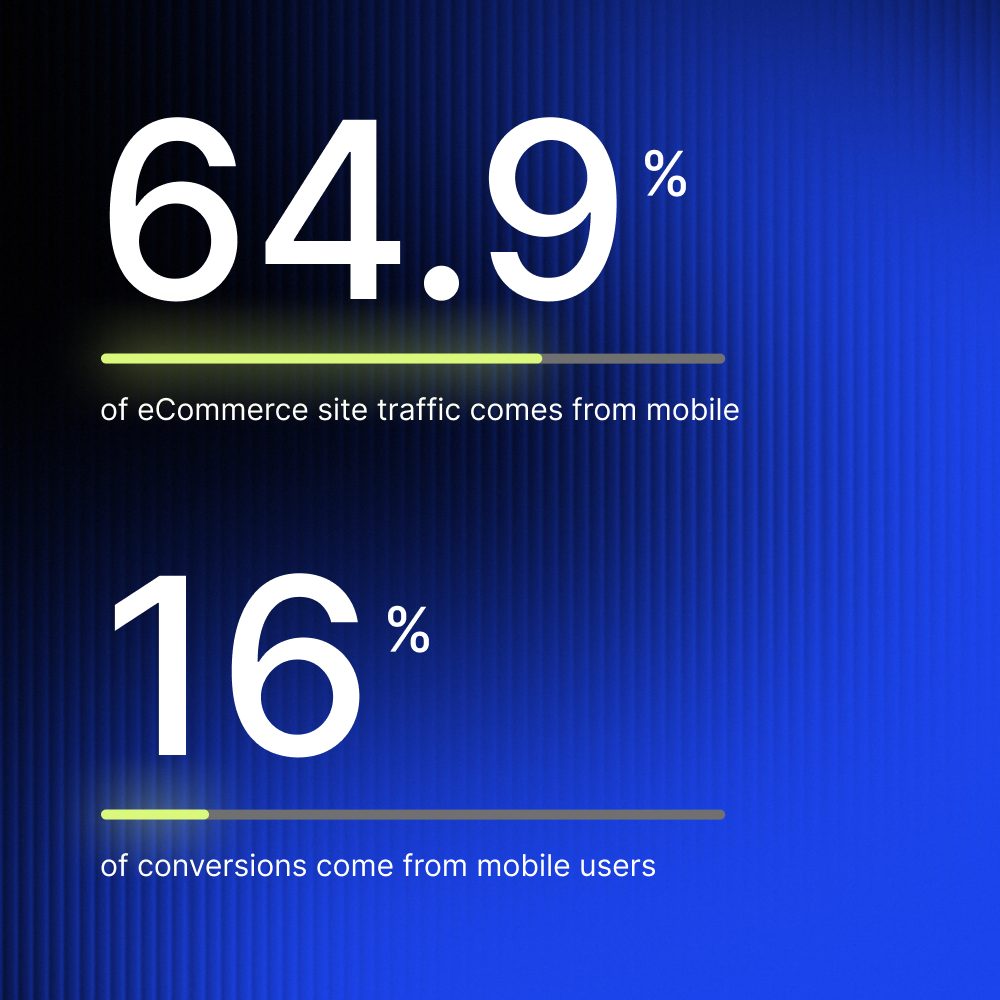Conversion rate optimization (CRO) is essential if you’re looking to maximize sales and improve the customer experience. A high conversion rate means that more visitors to your eCommerce platform go on to, for example, purchase your products, sign up for your newsletter or even create a customer account, which often highlights a repeat conversion opportunity. To help you improve your conversion rate, Novatize offers a number of strategies to strengthen your CRO.
B2B conversions vs. B2C conversions
For a B2B company, a conversion can take many forms. For example, it can include the generation of qualified leads, such as registering for a product demonstration, downloading white papers or case studies, or even submitting contact forms for personalized quotes. These actions are often the start of longer, more complex sales cycles. For a B2C company, conversion is generally more direct and immediate, and mainly includes actions such as purchasing products, subscribing to newsletters or registering in loyalty programs. B2C sales cycles are often shorter, and rely on consumers’ emotions and impulsivity to encourage purchase.
Ways to optimize your conversion rate
1. Ways to optimize your conversion rate
Simple, intuitive navigation:
Make sure your navigation menus are clear and intuitive. Users need to be able to find what they’re looking for quickly.
Detailed product descriptions:
Use high-quality images, detailed descriptions and customer reviews to convince visitors to buy.
Fast, smooth checkout:
Reduce the number of steps required to complete a purchase. For example, with a one-step checkout option, customers can enter their payment and shipping information on a single page.
Multiple payment options:
Offering multiple payment options helps to reduce friction and purchase hesitation on the part of the future consumer. For example, you could offer the possibility of making payments in several payments (Sezzle, Paybright).
Personalized customer portal:
A personalized customer portal enables B2B companies to manage their accounts, track orders and view purchase history. For example, an intuitive dashboard offering detailed reports and real-time analysis can help your customers make informed decisions.
For B2B companies, the specialists at Novatize have prepared an article on “UX-experience best practices for your B2B eCommerce“.
2. How to increase your CRO with your marketing strategy
Personalization:
Use customer data to personalize your marketing campaigns. Send product recommendations based on your customers’ purchase history and preferences. For example, if you offer a birthday discount to your customers, you could run a personalized campaign based on their preferences to encourage them to spend their birthday discount on products they’ve searched for in your product catalog.
Email marketing:
Create targeted email campaigns to build customer loyalty and keep them coming back to your site. For example, you could also create a flow that sends an email to buyers who leave an item in their shopping cart, offering them a discount on their order.
Free delivery:
This allows customers to benefit from free delivery under certain conditions, which encourages them to buy. For example, you can offer free delivery on purchases over a certain amount. You may even decide to display a progress bar showing the amount still to be spent to reach free delivery. Finally, to further encourage conversion, you could even suggest, at the checkout stage, different products from your catalog that will enable the buyer to reach the minimum limit required to qualify for free delivery.
Upsell and cross sell:
The upsell method consists in encouraging the customer to buy a more expensive or improved version of the product they are considering. The cross sell method consists in offering products that are complementary or related to the main product. For example, when a customer buys a phone, offer a model with more features (upsell) or accessories such as headphones or a protective shell (cross sell). This strategy will primarily have an impact on CLV and average basket, but can also have a positive impact on CRO.

Loyalty points system:
Reward your customers for their purchases and interactions with the brand. With every purchase, your customers accumulate points that they can redeem for discounts, free products or other exclusive benefits. For example, every dollar spent on your eCommerce site could earn 10 loyalty points. When a customer reaches 1,000 points, they could be eligible for a $10 discount.
Subscription system:
Offer your customers the possibility of receiving their favorite products on a regular basis without having to place a new order each time (personal care products, food, beverages, etc.). For example, you could offer a subscription that allows your customers to receive their product every month at a reduced price.
Referral programs:
Set up referral programs where your existing customers can recommend your services to other companies in exchange for rewards or discounts. For example, you could choose to offer a 10% discount on a future order for every new customer referred and who makes a purchase.
Reviews and certifications:
Products with good reviews will certainly be more attractive to customers. They’ll have more confidence in the brand and the products if they know that buyers have enjoyed their order. Encourage your customers to leave reviews, and offer them an incentive to do so. This is also the case for products or brands that have badges, certifications, won awards, etc. Clearly display these on your product sheets to encourage prospects to place their trust in you.
Your promotional strategy is bound to have an influence on your customers’ buying behavior, and this is even truer when the economic situation is more difficult. Find out how your eCommerce promotion strategy can be a pillar of resistance.
3. How to increase your CRO with good eCommerce development
Loading speed:
Optimize your site’s speed by compressing images and using quality hosting. A fast site reduces bounce rates and increases conversions.

Mobile-Friendly:
Make sure your site is fully responsive and works well on all mobile devices. In 2024, 64.9% of eCommerce site traffic will come from cellphones, but only 16% of conversions will come from mobile users. (1)
Security and compliance:
Strengthen your site’s security with SSL certificates and advanced security protocols to reassure your customers that their data is protected. For example, add a page on your eCommerce site that transparently indicates how user data will be used, and add a pop-up so visitors can customize their consent preferences. To find out more about Law 25, read this article.
Comments section:
Add a comments section to allow customers to share their opinions and shopping experiences. This increases the transparency and credibility of your eCommerce site. For example, in the comments section, you could allow buyers to attach a photo of the product they purchased on your eCommerce.
Unified commerce:
Unified commerce enables companies to track their customers’ buying journeys both online on different platforms and in physical stores. It offers the possibility of centralizing data collected ethically and with the consent of users, and then using it to personalize the experience. For example, a manufacturer with several distribution centers can offer its customers an online ordering experience that remains consistent, in a single shopping cart, despite inventory challenges.
To find out more about unified commerce, click here.
4. How to increase your CRO with good logistics management
Inventory management:
Use an inventory management system to avoid stock-outs and guarantee fast delivery times. “45% of customers abandon their shopping cart due to unsatisfactory delivery options”. (2) For example, by using an automated inventory management system, you can monitor stock levels in real time, forecast future needs and replenish products before they run out.
A high-performance PIM can help you improve the accuracy of product information, speed up time-to-market and offer customers a seamless shopping experience. To find out more.

Delivery options:
Offer multiple delivery options to meet the varied needs of your customers and enhance their experience. For example, you could offer express delivery or in-store pick-up options.
Easy return policy:
A clear and straightforward return policy can help you reassure your customers and encourage them to finalize their purchase. For example, you could install a “chatbot” on your eCommerce that allows customers to communicate in real time with a virtual assistant to answer their questions. Find out more about reverse logistics and returns.
Repeat order management:
For your B2B customers, make recurring orders easier by allowing them to save frequent orders or by offering automatic replenishment options. For example, you could add a feature that duplicates orders placed with a single click to speed up the purchasing process.
Optimizing your conversion rate (CRO) is essential to maximizing sales and delivering a good customer experience. Whether you specialize in B2B or B2C, the right strategies can turn your visitors into loyal customers. At Novatize, we understand the importance of an integrated, personalized approach for every type of business. Our specialists are available to help you implement these strategies to maximize your online success. With the right strategies and a commitment to continuous improvement, you can transform your eCommerce platform into a high-performance, sustainable growth engine.
Want to optimize your eCommerce conversion rate?
Inspired by what you’ve read?
Our team of experts can help you take your eCommerce to the next level!

